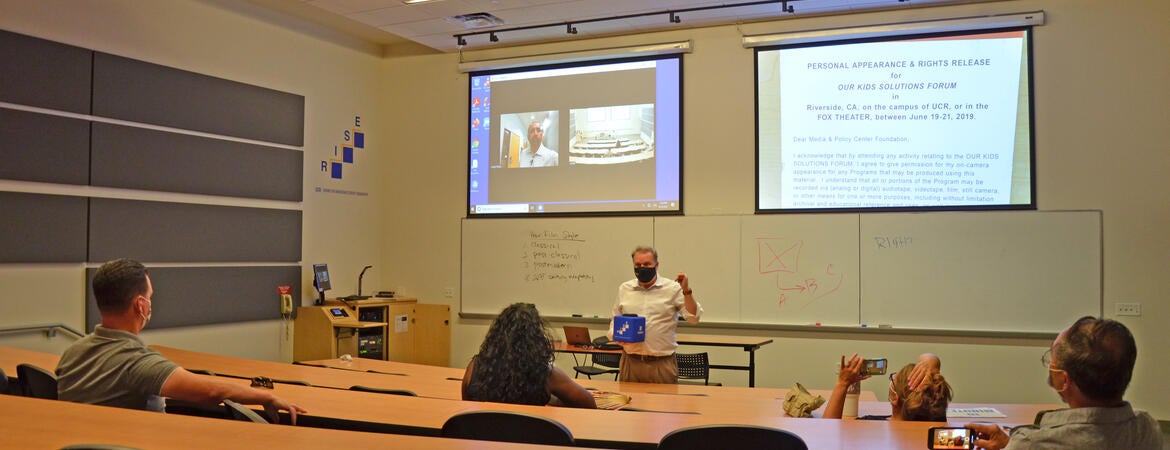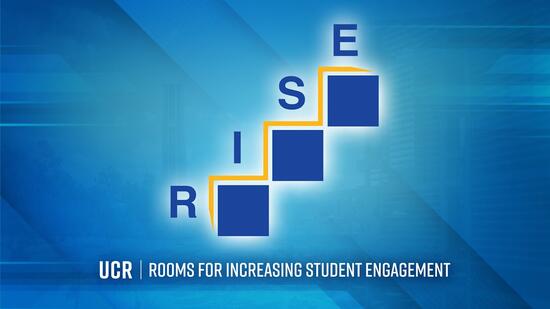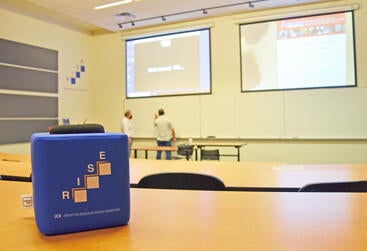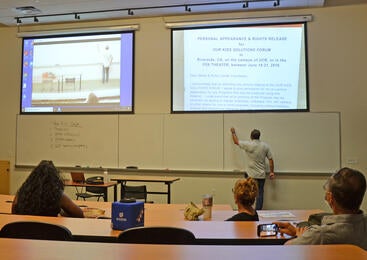
UC Riverside is on the RISE. Rooms for Increasing Student Engagement, or RISE, is a campus-wide initiative to transform classroom technology to meet the education needs of tomorrow and secure the University’s longevity as a top-ranked teaching and research institution.
This strategic investment in UC Riverside’s learning environments includes technology upgrades to all 110 general assignment classrooms. This technology will help increase student engagement and enhance learning, provide faculty with new tools that facilitate pedagogical exploration, and effectively expand UCR's campus blueprint digitally to accommodate a growing student population. Most importantly, this initiative is in keeping with UCR's commitment to social mobility as it creates equitable access to higher learning by meeting students where they are and removing barriers to their success.
“The last year has shown a spotlight on the resiliency and resolve of UC Riverside students, faculty, and staff,” said Vice Provost and Dean for Undergraduate Education Jennifer Brown. “Now, we turn our attention to the future and embrace new possibilities. RISE endeavors to create a more inclusive, collaborative, and equitable University experience for all.”
New Teaching Opportunities
The classroom technology upgrades are meant to expand instructors’ pedagogical toolbelt, allowing them to explore which methods work best to enhance their courses and better engage students.
As students and faculty return to campus for the fall 2021 quarter, they can expect to identify RISE classrooms by the RISE logo placed inside. An unobtrusive pan, tilt, zoom (PTZ) camera mounted at the back of the room boasts pre-set scenes that allow the instructor to easily broadcast or record the lecture while capturing whiteboard details or in-class demonstrations in high definition. Similarly, advanced audio systems can be found in all RISE rooms. In small classrooms, an all-in-one voice-tracking microphone array can integrate with Zoom to provide real-time 2-way discussion with remote participants or guest speakers, or similarly integrate with YuJa to provide high-resolution audio for course capture. Larger classrooms come equipped with an instructor mic lapel and catchbox microphone to allow for both in-room and remote audio amplification and capture. Whether a student sits at the front or back of the room, they will be heard audibly when using the catchbox during discussion. Students and guest speakers participating remotely will be heard through classroom speakers, and can even appear to the class via video on the projection screen if the instructor so chooses. Classrooms with dual projectors can display with high resolution slide deck presentations, Zoom participants, and doc camera or whiteboard capture simultaneously. These are some of the many new teaching options available to instructors—all of which can be accessed through a convenient touch-screen control panel at the front of the room.
“Thorough research went into determining which technologies were most appropriate for this initiative,” said Rebecca Hutchins, Associate CIO for Service Assessment and Promotion for Information Technology Solutions (ITS). “It was important to find agile solutions that accommodate the needs of a diverse and growing student population and rapidly changing education climate, while also sustaining established teaching methods to ensure instructors are not required to recreate lessons or produce separate course plans.”
In fact, RISE is committed to ensuring faculty have the support needed to easily and effectively incorporate the new classroom technology.
In-person Support for Faculty
An important component of RISE is its Instructional Continuity Consultants (ICC) program. The UCR Exploration Center for Innovative Teaching and Engagement (XCITE) hired 48 graduate students to serve as points of contact should instructors have an issue with teaching modality in designated RISE rooms.
All departments on campus will have a designated ICC who is familiar with the courses and instructors. This is because ICCs were strategically paired with the department in which they are receiving their degree. In the few cases where there were no program applicants, an ICC receiving a degree in a similar field of study was assigned to the department. Each of UCR’s seven professional schools will also have a Lead ICC to serve as a primary point of contact and provide escalation support.
In the event the issue cannot be resolved by the departmental ICC or Lead, it will be escalated to Tier 2 and professional staff at XCITE will work to resolve the issue. In the event the issue is related to a technical problem with the equipment, it will be reassigned to an on-call ITS Multimedia technician.
“The ICC program is more than a liaison service—it’s a rapid response support team,” said XCITE Director Richard Edwards. “We are working closely with departments to understand faculty schedules to ensure immediate response from the appropriate support staff is available. When it comes to delivering high quality pedagogy, it’s imperative that faculty have quick access to the proper resources.”
In addition to the ICC program, XCITE and ITS are working to develop on-demand training videos and classroom equipment guides for faculty. In early September instructors and department Chairs are also invited to attend RISE “Open Houses” to tour the space and interact with the new equipment.
The Future of Learning at UC Riverside
The undertaking is made possible through the joint efforts of UCR’s Information Technology Solutions (ITS) and Exploration Center for Innovative Teaching and Engagement (XCITE), who have partnered to secure resources and plan and implement this campus-wide initiative.
“The University has made this investment because it recognizes that this is a pivotal moment in higher education,” said Edwards. “Just as we saw the need to incorporate projection equipment in classrooms in the early 2000s and in-room desktop computers in the early 2010s, so, too, are we recognizing the need to incorporate cutting-edge multi-mode video and audio equipment in classrooms in the early 2020s.”
In an immediate sense, this technology makes classroom participation possible for international students currently facing travel restrictions, as well as students unable to make it to campus due to health or financial concerns. In the long-term sense, these classroom upgrades allow for teaching exploration and innovation, giving academic departments the technology flexibility and scalability needed to support student population growth.
“RISE is an opportunity to remove barriers to students’ success and set our sights on the future of learning at UCR,” said Interim Chief Information Officer and Associate Vice Chancellor Josh Bright. “Continuous investment in students, faculty, and information technologies have proven to be a recipe for success, so we are excited to see what UCR is able to achieve in this next chapter.”
UC Riverside has committed to having at least 80% of fall courses take place in person. As part of campus’ cautious reopening, larger lecture halls will remain closed. RISE room assignments and determinations about remote access to courses will be determined by faculty in coordination with their departments. To learn more about RISE, visit https://ontherise.ucr.edu/.


